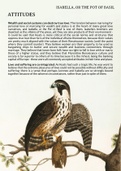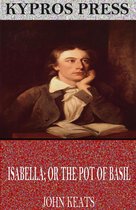ISABELLA, OR THE POT OF BASIL
ATTITUDES
Wealth and social customs can destroy true love: The tension between marrying for
personal love or marrying for wealth and status is at the heart of many great love
narratives, and Isabella, or the Pot of Basil is one of them. Isabella’s brothers are
depicted as the villains of the piece, yet they are also products of their environment -
it could be said that Keats is more critical of the social norms and strictures that
oppress true love than he is of the individual villains themselves, because their values
are pretty much aligned with the values of their Renaissance society (until the point
where they commit murder). They believe women are their property, to be used as
bargaining chips to barter and secure wealth and business connections through
marriage. They believe that lower born folk have no right to fall in love with or marry
those of a higher status, and they believe that Florentine Renaissance culture and
society is far superior to others of its time because it is the richest, being the banking
capital of Europe - these were all commonly accepted attitudes in their time and place.
Love and suffering are co-integrated: As Keats had such a tragic life, he was wont to
believe that the extreme pleasures of love could not be possible without difficulty and
suffering; there is a sense that perhaps Lorenzo and Isabella are so strongly bound
together because of the adverse circumstances, rather than just in spite of them.
, Forbidden love is often tragic and painful: Isabella
and Lorenzo are ‘twin roses’, they are clearly matched
for one another and their union is pure and honest;
however, due to the disparity in wealth and status,
society would dictate that Lorenzo is an unfit match
for Isabella. For this reason, their love is socially
forbidden and this puts a lot of pressure on the
relationship, forcing it into secrecy. The lovers are still
happy with arrangements until the brothers
intervene, feeling that it is their right to murder
Lorenzo and wed Isabella to a wealthier suitor, to
further their own profits and connections. The
scenario parallels the tragic tale of Romeo and Juliet,
another Italian Renaissance story of doomed lovers
where the central characters are perfectly suited, yet
the wider context of their feuding families prevents
them from achieving a happy union. Keats uses
allegorical referencing to Shakespeare’s play to place
his own tale (originally Bocaccio’s) within the
discourse of tragic love narratives.
CONTEXT
Written 1818: This is one of Keats’ most prolific and famed years in terms of his poetic
career; the poem was also published around the same time as Keats’ relationship with
Fanny Brawne began to blossom. Frances Brawne Linden, otherwise known as Fanny,
was Keats’ neighbour in Hampstead, London. She was striking and distinctive looking
rather than conventionally attractive, and she had a fiery passion for literature and
politics that fascinated and perplexed Keats. They began a courtship in 1818 and were
engaged in October 1819, but Fanny’s mother refused to sanction the marriage until
Keats had achieved financial stability - at that time he had stopped his training as a
physician to dedicate more time to poetry, which was (as it is now) an unstable career
choice. Keats’ own physical health deteriorated, and by February 1820 it was clear
that he suffered from tuberculosis; he was forced to take a trip to Italy with hopes that
the weather would improve his health but sadly he died in February 1821 without ever
marrying his beloved. When applying this contextual knowledge to the poem, be
careful of dates - at the time that ‘Isabella’ was written Keats had not yet been
diagnosed with tuberculosis or had troubles with his engagement, he had however
met Fanny Brawne and begun a courtship with her; he had also cared for his brother
Tom since 1817, who was himself sick with tuberculosis and died of it in late 1818 - it
is thought that Keats’ care of his brother was the reason that he himself contracted
the disease.






